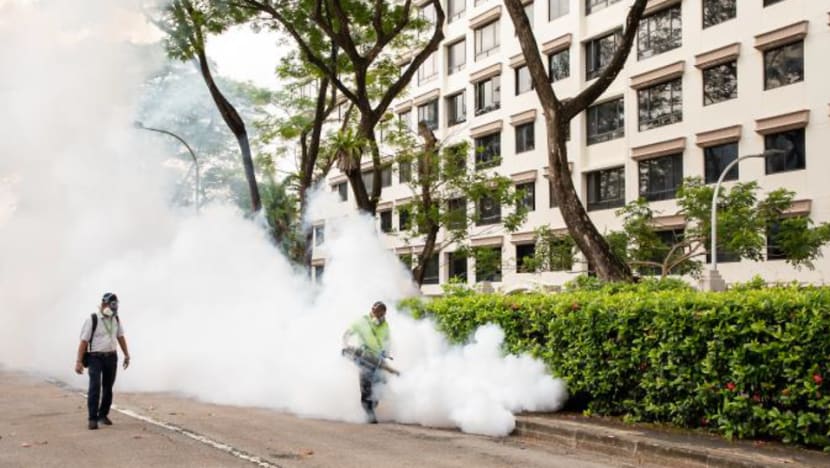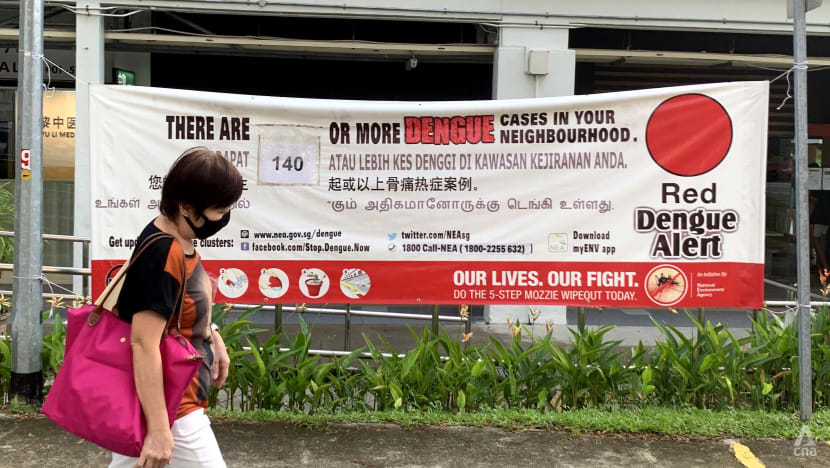commentary Commentary
Commentary: Record dengue cases complicates Singapore's fight against COVID-19
People being at home more could be one of the factors driving record dengue cases, says Assistant Professor Hannah Clapham.

NEA officers conducting fogging at the Woodleigh Close dengue cluster. (Photo: National Environment Agency)
SINGAPORE: This year is a record-breaking year for dengue in Singapore. This year, of course, is also a record-breaking year for COVID-19 in Singapore.
What are the similarities and differences between the transmissions of these two diseases, how have COVID-19 and dengue interacted in Singapore, and what should we expect in the coming months?
We are all very familiar with the COVID-19 situation in Singapore. Case numbers have been high over the last few months but have been coming down in recent weeks.
After a period of restricted movement, we are now entering Phase 2, and more activities are allowed, but with still a considerable number of public health measures in place.
LISTEN: Entering Phase 2: What's behind rules on gatherings, dining, weddings and more?
READ: Commentary: The road to a COVID-19 vaccine is long and narrowing
RECORD DENGUE CASES
Dengue transmission varies in Singapore from year to year.
Going into 2020, higher than usual case numbers suggested we might be heading for a big year. In the last few weeks, we have seen the explosion of cases that we hoped would not happen.
The number of cases and active clusters have been increasing rapidly, and the National Environment Agency (NEA) are stepping up their control efforts. According to NEA data, two weeks ago Singapore reported 1,158 cases – a 33 per cent increase from the previous week and a record number of weekly cases in the country.
As of Jun 18, there were 258 active dengue clusters in Singapore.
The big difference between the two diseases is that COVID-19 is spread from person-to-person, and dengue is spread from human-to-mosquito-to-human.
The circuit breaker has reduced our person-to-person contact, and so we have seen decreases in COVID-19 and diseases like influenza during this period, but the reduction in contact during the circuit breaker has not led to reductions in dengue cases.
There is much discussion about why we are seeing a record-breaking year for dengue. There will be much research in the coming months and years, including my own, to understand this. However as with everything in dengue, I think it is complicated.
For dengue, a number of factors come together to lead to transmission and cases being higher or lower in different places and at different times.

These factors include the weather, numbers of mosquitoes, human exposure to mosquitoes, virus serotypes and population immunity.
This year in Singapore we have seen a number of these factors change compared to previous years: More mosquitoes as found by NEA inspections, changes in exposure as people are spending more time at home, as well a different serotype compared to previous years.
The mosquitoes that spread dengue tend to bite during the day. Therefore, where people are during the day is important as it impacts their risk of getting bitten.
NEA inspections have revealed many mosquitoes and clusters at home, therefore being at home more during the day could be leading to more exposure to mosquito bites and dengue cases.
For a short-term response, we need to understand what we can about the drivers and then to focus on what can be changed now.
READ: Commentary: The truth behind returning wildlife is less feel-good than you think
The main outcome being aimed for is a reduction in the numbers of bites people get from mosquitoes. This reduction can be brought about by reductions in mosquito numbers, as well as reduction in exposure to mosquitoes.
PERSONAL AND PUBLIC RESPONSES IMPORTANT
For both dengue and COVID-19, public health responses will lead to changes in our surroundings, with the aim of reduction transmission, but there are also actions we are being asked to take ourselves in our homes and workplaces.
We all know very well for COVID-19 the public health actions that are on-going, and how workplaces and public places are responding currently.
For dengue, NEA has for many years had in place responses, rules and regulations with the aim of reducing mosquito numbers through activities like fogging and breeding site removal.
In addition, over the last few years, Wolbachia mosquitoes have been released as part of a suppression strategy with the aim of reducing mosquito numbers.
Moreover, the actions we are being encouraged to take ourselves can make a difference to transmission.
For COVID-19 those individual actions are the things we have heard a lot about over the last few months, including wearing masks, washing hands and having fewer physical interactions with other people.
READ: Commentary: The coronavirus has made all of us OCD
For those actions it is quite easy to see how they reduce the spread of COVID-19 by reducing the number of contacts or the risk of infection given a contact.
For dengue, because the spread is via mosquitoes, the relevant actions may feel further removed.

However, they are not any less integral to reducing transmission. For example, clearing breeding sites in our homes and wearing mosquito repellent works to reduce the numbers of contacts with mosquitoes or the risk of an infectious contact via a bite from a mosquito.
These in turn therefore reduce the spread of dengue.
COVID-19 and dengue also both likely have asymptomatic or pre-symptomatic transmission, this is partly why we are advised to take these actions pre-emptively and not just when we have symptoms.
We are also of course asked to take these actions so as to reduce the risk of getting infected in the first place.
In addition, for both COVID-19 and dengue, we are advised to take focused actions when we know transmission is near, like when people have been contact-traced for COVID-19 and therefore have to quarantine, or the stepping up of preventive measures in the house or workplace when these are in a red or orange zone for dengue.
CHALLENGES OF HAVING BOTH DISEASES
For Singapore in 2020, one of the big worries with having both COVID and dengue at the same time is that there will be large numbers of patients seeking care leading to an overwhelmed healthcare system thus affecting hospitals’ capacities to provide other services.
As we have seen so far, through a combination of expanding healthcare capacity and bringing in population measures like the circuit breaker, Singapore has dealt well with mitigating and dealing with increases in COVID-19 cases.
READ: Commentary: The systematic testing Singapore needs to ditch circuit breakers for good
I’m sure this will continue to be the case with dengue and COVID-19, but the question will be, depending on how much spread there is of both in Phase 2, how much does the healthcare system need to adapt, and what public health measures will also need to be in place.
So, what should we expect over the next few months? As our lives change again with Phase 2 we expect to see COVID-19 cases increase, but with the knowledge that there are measures in place that aim to limit transmission as well as detect and deal with these cases when they arise.
For dengue, with more people going back to work, and spending more time outside the home, exposure will be changing again.
Therefore, the focus will be on reducing mosquito numbers and exposure to mosquitoes in the places where people are now spending more time.
The NEA will be continuing surveillance and reporting so we will know where dengue transmission is happening to enable us to respond.
However, we are currently in a phase of rapid growth of dengue cases, and given the weather currently, growth can unfortunately be predicted to continue, and this must be planned for.
As always in public health, hopefully our actions mean that this prediction will be wrong.
BOOKMARK THIS: Our comprehensive coverage of the novel coronavirus and its developments
Download our app or subscribe to our Telegram channel for the latest updates on the coronavirus outbreak: https://cna.asia/telegram
Hannah Clapham is an assistant professor at the Saw Swee Hock School of Public Health at the National University of Singapore and was previously the head of modelling at the Oxford University Clinical Research Unit in Ho Chi Minh City.














